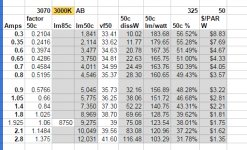Beta Test Team
Member
[NOTE #1: The original thread title ("LED vs. HPS: A reality check") was from the first PDF below. But a few LED growers got mad at the title, so to try to keep the thread on-topic I changed the title - but not the content]
[NOTE #2: I added the following sentence to this post to try and keep this thread on-topic: "This thread is about the photosynthetic efficiency of luminaries, and their irradiance uniformity, that is, converting watts into photosynthetic photons and the uniformity of the footprint."]
This research includes some interesting data on the efficiency of LEDs vs. HID in terms of converting watts (j/s) into flux (umol/s, that is, photosynthetic photon output). The main metric is efficiency defined as photosynthetic umol/J.
When accounting for most LED price points, and lowish umol/s per joule compared to HPS, many LED brands may not be as efficient and powerful as their makers tend to claim, and the same goes for HID luminaires.
None of this is to say LEDs aren't great technology, it is, but it does suggest the way they're used make a huge difference in their efficiency and worth as compared to HID. In other words, for large grows of high irradiance plants, LEDs are not as efficient they're often claimed (when accounting for price, etc.).
Here's a short report by Dr. Runkle, Dr. Nelson, and Dr. Bugbee:
http://www.gpnmag.com/sites/default/files/14_TechnicallySpeaking_GPN0614.pdf
And another by Dr. Nelson and Dr. Bugbee:
http://cpl.usu.edu/files/publications/poster/pub__9913943.pdf
And here's the source material, a published study (April, 2014) by Dr. Nelson and Dr. Bugbee:
Economic Analysis of Greenhouse Lighting: Light Emitting Diodes vs. High Intensity Discharge Fixtures
http://www.plosone.org/article/info%3Adoi%2F10.1371%2Fjournal.pone.0099010
Last edited:




